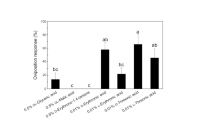Abstract
Avoidance of some crucifer species by the crucifer specialist,Pieris rapae, has been attributed to the presence of oviposition deterrents in these plants. Studies on one such unacceptable plant,Erysimum cheiranthoides, have resulted in the isolation ofn-butanol-soluble deterrents from the alcoholic extract of foliage. The active fraction contained three cardiac glycosides, which were isolated by reversed-phase HPLC and by open column chromatography on silica gel. Chemical and spectral evidence (UV, [1H]NMR, and FAB-MS) led to the characterization of these compounds as erysimoside (1), erychroside (2), and erycordin (3). Erysimoside and erychroside were strongly deterrent toPieris rapae, but erycordin was inactive. Both active compounds have the same aglycone, strophanthidin (5) and the inner sugar in both cases is a 2,6-dideoxy hexose to which the outer sugar is attached at position C-4. These structural features, which are absent in the inactive compound (3), may represent specific requirements for oviposition deterrent activity.
Similar content being viewed by others
References
Krebs, K.G., Heusser, D., andWimmer, H. 1969. Spray reagents, pp. 854–911,in E. Stahl, (ed.). Thin-layer Chromatography, English translation. Springer-Verlag, Berlin.
Makarevich, I.F., andKolesnikov, D.G. 1965. Cardenolides of the seeds ofErysimum cheir-anthoides L. Khim. Prir. Soedin. 1 (5):286–287 (English translation).
Moore, J.A., Tamm, C., andReichstein, T. 1954. Die Glykoside der Goldlacksamen,Cheiranthus cheiri L.Helv. Chim. Acta 37:755–770.
Renwick, J.A.A., andRadke, C.D. 1983. Chemical recognition of host plants for oviposition by the cabbage butterfly,Pieris rapae (Lepidoptera: Pieridae).Environ. Entomot. 12:446–450.
Renwick, J.A.A., andRadke, C.D. 1985. Constituents of host and non-host plants deterring oviposition by the cabbage butterfly,Pieris rapae.Entomol. Exp. Appl. 39:21–26.
Renwick, J.A.A., andRadke, C.D. 1987. Chemical stimulants and deterrents regulating acceptance or rejection of crucifers by cabbage butterflies.J. Chem. Ecol. 13:1771–1776.
Renwick, J.A.A., Radke, C.D., andSachdev-Gupta, K. 1989. Chemical constituents ofErysimum cheiranthoides deterring oviposition by the cabbage butterflyPieris rapae.J. Chem. Ecol. 15:2161–2169.
Rittel, W., Hunger, A., andReichstein, T. 1952. Digitalinum verum und Strospesid (=Desglucodigitalinum verum), Berichtigung früherer Angaben.Helv. Chim. Acta 35:434–441.
Rothschild, M., Alborn, H., Stenhagen, G., andSchoonhoven, L.M. 1988. A strophanthidine glycoside in the Siberian wallflower: A contact deterrent for the large white butterfly.Phytochemistry. 27(1):101–108.
von Euw, J., andReichstein, T. 1948. Die Glykoside der Samen vonStrophanthus nicholsonii Holm. Glykoside und Aglykone.Helv. Chim. Acta 31:883–892.
Author information
Authors and Affiliations
Rights and permissions
About this article
Cite this article
Sachdev-Gupta, K., Renwick, J.A.A. & Radke, C.D. Isolation and identification of oviposition deterrents to cabbage butterfly,Pieris rapae, fromErysimum cheiranthoides . J Chem Ecol 16, 1059–1067 (1990). https://doi.org/10.1007/BF01021010
Received:
Accepted:
Issue Date:
DOI: https://doi.org/10.1007/BF01021010




